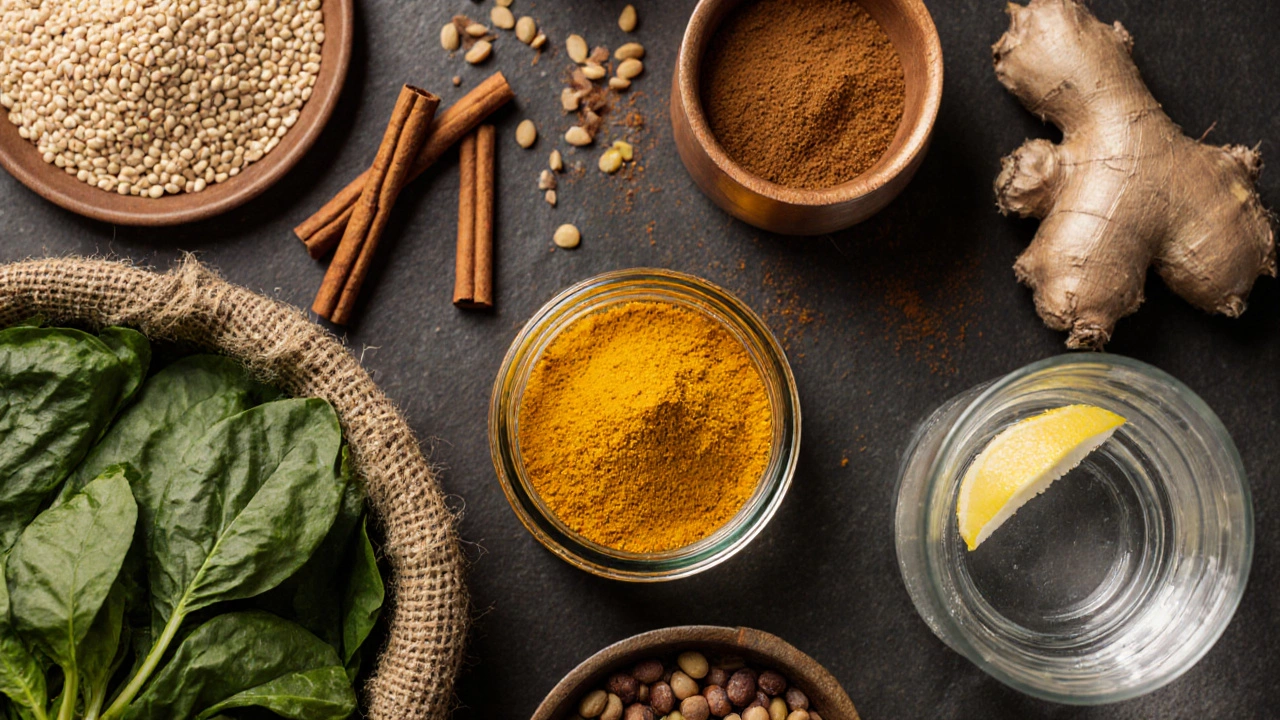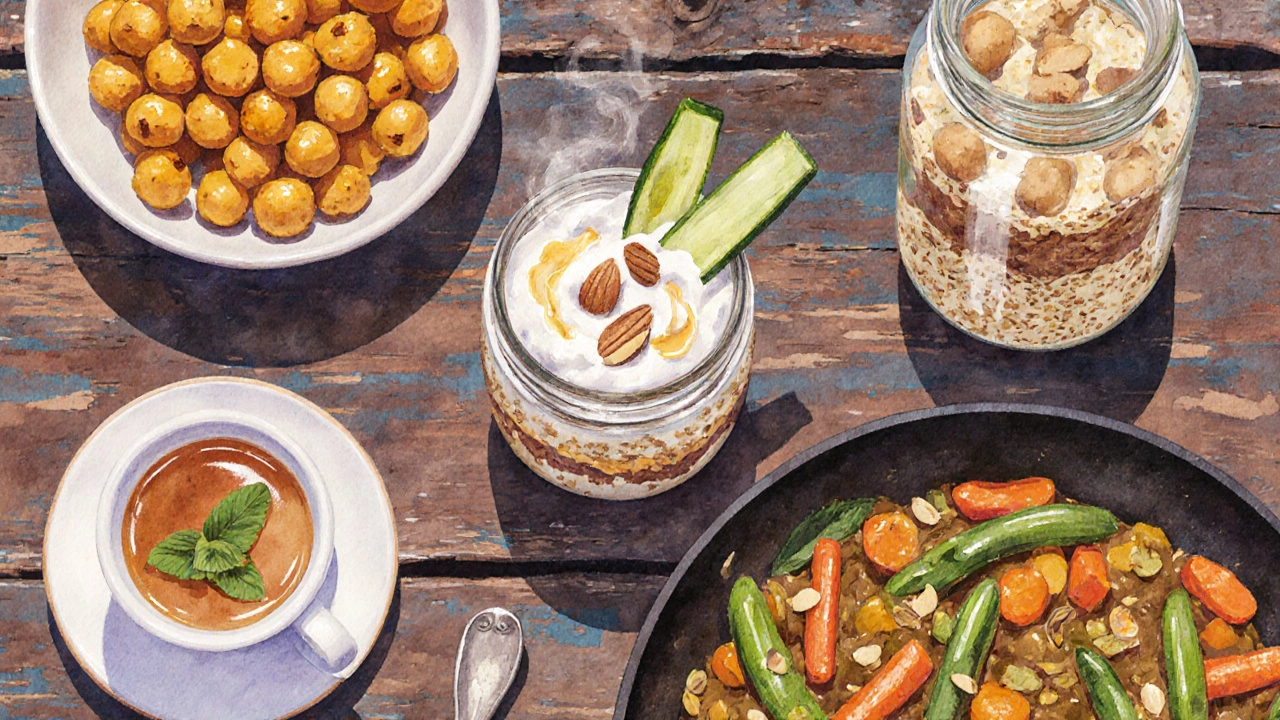Top Indian Foods That Help Burn Fat - Simple Snacks & Meal Ideas

Fat-Burning Food Calculator
Calculate Your Fat-Burning Meal
Select foods from the article to see their calorie, fiber, and nutrient content. Perfect for planning healthy Indian meals.
Nutrition Results
Calculate your meal to see calories and nutrients.
Ever wondered which Indian foods actually help you trim unwanted pounds? Fat‑burning Indian foods are not a myth - they’re real, tasty options that fit right into everyday meals. This guide shows you the science behind each ingredient, gives you quick snack ideas, and points out common mistakes to avoid.
Quick Takeaways
- Spices like turmeric, cinnamon, and fenugreek boost metabolism and curb cravings.
- High‑fiber staples such as millets, lentils, and leafy greens keep you full longer.
- Hydrating drinks (coconut water, ginger‑spiced tea) support fat‑oxidation without added sugar.
- Combine these foods with mindful portion control for steady weight loss.
- Swap refined carbs for whole‑grain alternatives to keep blood sugar steady.
Why Certain Indian Foods Burn Fat
Each food on the list has at least one of three fat‑burning mechanisms:
- Thermogenic compounds that raise body temperature and calorie expenditure.
- High fiber that slows digestion, stabilizes blood glucose, and reduces overall calorie intake.
- Micronutrients that improve hormone balance (especially insulin and leptin).
Below are the star players, why they work, and how much you’d typically need for a noticeable effect.
Star Ingredients and Their Fat‑Burning Power
Turmeric a bright yellow spice containing curcumin is famous for its anti‑inflammatory properties, but curcumin also activates brown fat and raises metabolic rate. A study from the Indian Council of Medical Research found that 500mg of curcumin daily increased resting metabolic rate by roughly 8%.
Fenugreek seeds rich in soluble fiber and saponins slow carbohydrate absorption, which blunts insulin spikes. Lower insulin means the body is more likely to tap stored fat for energy. One 30‑gram serving of fenugreek powder has been shown to reduce post‑meal blood sugar by 15%.
Cinnamon the sweet bark used in many Indian desserts contains cinnamaldehyde, a compound that improves insulin sensitivity. Research published in the Journal of Nutrition (2023) reported a 12% rise in fat oxidation after just two weeks of daily cinnamon intake.
Ginger a root with gingerol and shogaol boosts thermogenesis and reduces hunger hormones like ghrelin. A typical ginger‑tea (about 2g fresh ginger) can raise calorie burn by 5% during a 30‑minute walk.
Moringa the drumstick tree leaves, often used in dals and soups offers a high concentration of antioxidants and protein. Its low‑calorie, high‑nutrient profile helps maintain lean muscle while you cut fat.
Millet (Bajra, Jowar) ancient grains rich in soluble fiber replace refined wheat in rotis and upma. The fiber content (about 7g per 100g) keeps you feeling full for up to 3hours, cutting the urge to snack.
Lentils (Dal) legumes packed with protein and fiber boost satiety and preserve muscle mass during calorie deficits. One cup of cooked lentils provides roughly 18g of protein and 16g of fiber.
Coconut water a natural electrolyte drink from young coconuts is low in sugar compared with commercial sports drinks and contains potassium, which helps regulate metabolism.

Quick Snack & Meal Ideas Using Fat‑Burning Ingredients
Below are five easy recipes you can whip up in under 15minutes. They’re designed for busy people who still want authentic Indian flavor without extra calories.
- Turmeric‑Spiced Roasted Chickpeas: Toss canned chickpeas with ½tsp turmeric, a pinch of black pepper, spray with olive oil, and bake at 200°C for 12minutes. One cup serves about 150kcal and provides 5g fiber.
- Fenugreek‑Lemon Yogurt Dip: Mix plain Greek yogurt (100g), 1tsp fenugreek powder, juice of half a lemon, and a sprinkle of cumin. Use as a dip for cucumber sticks.
- Cinnamon‑Almond Overnight Oats: Combine rolled oats, almond milk, ½tsp cinnamon, a handful of sliced almonds, and a drizzle of honey. Refrigerate overnight; eat cold for a filling breakfast.
- Ginger‑Green Tea with Mint: Steep a green tea bag with 2g grated ginger and a few fresh mint leaves for 3minutes. No sugar added - the spice satisfies cravings.
- Millet & Veggie Stir‑Fry: Cook millet (½cup) and stir‑fry with mustard seeds, curry leaves, chopped carrots, beans, and a dash of soy sauce. Finish with a squeeze of lime.
How to Incorporate These Foods Into Your Daily Routine
Consistency beats occasional binge‑eating. Here’s a simple framework you can adapt:
- Start with a thermogenic sip. Replace your morning coffee with ginger‑green tea or a cup of spiced masala chai (use low‑fat milk).
- Swap refined carbs. Use millet rotis or quinoa instead of white rice for lunch.
- Add protein‑rich legumes. Include a serving of dal or a lentil salad at dinner.
- Snack smart. Keep a jar of roasted chickpeas or a bowl of cucumber‑fenugreek yogurt ready.
- Hydrate with electrolytes. Sip coconut water between meals rather than sugary sodas.
Following this pattern ensures you get a steady supply of metabolism‑boosting compounds throughout the day.
Common Pitfalls and How to Avoid Them
- Over‑spicing. While spices are beneficial, too much salt or oil can negate calorie savings. Measure oil (≤1tsp per serving) and keep salt under 1gram.
- Relying on “miracle” foods alone. Fat loss still requires a calorie deficit. Use these ingredients as tools, not excuses.
- Skipping protein. Protein maintains muscle while you lose fat. Pair high‑fiber carbs with lentils, tofu, or paneer (low‑fat).
- Skipping meals. Skipping can trigger binge‑eating later. Small, balanced meals keep metabolism active.
Comparison of Top Fat‑Burning Indian Foods
| Food | Primary Fat‑Burning Component | Calories (per 100g) | Fiber (g) | Typical Portion for Weight‑Loss |
|---|---|---|---|---|
| Turmeric (powder) | Curcumin | 312 | 22 | ½tsp (≈2g) |
| Fenugreek seeds | Soluble fiber, saponins | 323 | 24 | 1tsp (≈5g) |
| Cinnamon | Cinnamaldehyde | 247 | 53 | ½tsp (≈2g) |
| Millet (Bajra) | Soluble fiber | 378 | 7 | ½cup cooked (≈100g) |
| Lentils (cooked) | Protein & fiber | 116 | 8 | 1cup (≈200g) |
Putting It All Together - A One‑Day Sample Plan
- Morning: Ginger‑green tea (250ml) + 2 boiled eggs.
- Mid‑morning snack: Turmeric‑spiced roasted chickpeas (½ cup).
- Lunch: Millet rotis (2) with mixed vegetable dal (1 cup) and a side of cucumber‑fenugreek yogurt.
- Afternoon snack: A glass of coconut water + a small handful of almonds.
- Dinner: Grilled paneer tikka (100g) with a salad dressed in lemon and a pinch of cinnamon.
This menu stays under 1,600kcal, packs 45g of protein, and hits the daily fiber goal (≈30g). The spread of thermogenic spices keeps metabolism humming from dawn till dusk.
Frequently Asked Questions
Can I lose weight by eating only Indian spices?
Spices such as turmeric and cinnamon support metabolism, but they don’t replace a balanced diet. Weight loss still requires a modest calorie deficit and adequate protein.
How much fenugreek should I consume daily?
Most studies use 5‑10g of ground fenugreek per day. Start with 1tsp (≈5g) mixed into yogurt or smoothies and adjust based on taste.
Is coconut water safe for people with diabetes?
Unsweetened coconut water has a low glycemic index (≈3). A small glass (200ml) fits most diabetic meal plans, but monitor total carbohydrate intake.
Do I need to take supplements for these spices?
Whole‑food sources are usually best because they provide synergistic nutrients. Supplements may help if you can’t tolerate the taste, but stick to clinically tested extracts.
What’s the best time to eat these foods for maximum fat loss?
Spread them throughout the day: a thermogenic drink in the morning, fiber‑rich snacks mid‑day, and protein‑packed dinner. This keeps insulin steady and metabolism active.